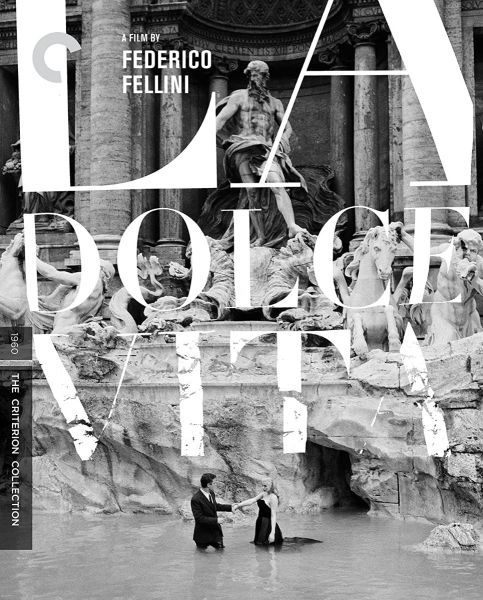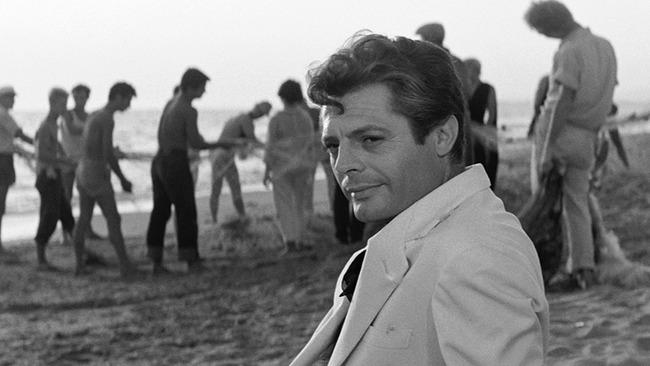One of those films weighed down by a considerable reputation, La Dolce Vita (1960) is rarely taken as seriously as it should be. From the very first sequence in which a figure of Christ sails across Rome’s skies, suspended from a helicopter, a sensational image that summed up the spiritual bankruptcy of the time, until the last when an innocent and beautiful girl smiles quizically in close-up, this is a deeply moral film.
On one level this satirical depiction of the “sweet life” consists of a series of wild parties, hosted and attended by the city’s beau monde, but it also a film about the emptiness of modern life, lived as it is for instant gratification and thrills. Unlike 8 ½ (1963) which has not aged so well, La Dolce Vita still feels relevant, as the world of PR, spin and celebrity culture it portrays has only become more inescapable. It is also, in spite of being overlong, a better film, perhaps Fellini’s best.
In a picaresque series of loosely connected sequences, we follow journalist Marcello, as he chases after society scoops, night and day. Played with great nuance by Marcello Mastroianni in his first truly major role, this man-about-town and chronicler has a troubled soul. Like many journalists, he would rather be a writer of literature. He is almost always accompanied by a swarm of paparazzi, who ride shotgun on his classy Triumph TR3 convertible, or follow him on scooters and jeeps. He is courted for his power as a celebrity-maker but also for his good looks and charm. There is plenty of glamour in the film: the cast of party-goers includes Anita Ekberg, Anouk Aimée and a marvellous array of almost surreal frocks
 Marcello enjoys the power of being a weaver of spin, but is constantly reminded of the worst aspects of his party animal’s life. There is desperately jealous girlfriend Emma (Yvonne Furneaux), an estranged father (a very moving performance from Annibale Ninchi) who visits him from the provinces, and collapses after a night of drinking and fun. And the wise and philosophical Steiner (Alain Cuny) who is tormented by a gloomy sense of humanity’s tragic future.
Marcello enjoys the power of being a weaver of spin, but is constantly reminded of the worst aspects of his party animal’s life. There is desperately jealous girlfriend Emma (Yvonne Furneaux), an estranged father (a very moving performance from Annibale Ninchi) who visits him from the provinces, and collapses after a night of drinking and fun. And the wise and philosophical Steiner (Alain Cuny) who is tormented by a gloomy sense of humanity’s tragic future.
The camera work (Otello Martelli) and direction, the subject of one of the disc’s illuminating bonuses, features a seamlessly edited mix of still wide shots within which the action unfolds and complicated shots that move and track around the space, picking up scenes-within-scenes featuring a polyphony of languages. The same technique partly graced 8 ½ , Satyricon (1969), Ginger and Fred (1986) and other Fellini classics, but here it was a ground-breaking indication of how cinema could find yet more ways of bringing images to life. In this case, the universe is not quite real and the film marks a transition from Italian neo-realism into something more poetic and ironic.
The film is pure satire, and the characters – with few exceptions, not least the journalist Marcello – are all caricatures. They mostly play a variety of roles that provide them with an identity and a vehicle with which they can affront society's spectacular stage. Fellini treats this play acting with humour and irony. The material is tragic, however. These glamourous people are all, to a greater or lesser extent, lost. By often making light of the character's superficiality, the film manages to be both entertaining and profoundly thought-provoking, but never in a didactic or obvious way.
The incessant parties, which include a ghost-hunt and a séance with a medium, build towards a crazy finale, in an acquaintance’s seaside house that the revellers break into. Steiner, the core of sanity and wisdom in Marcello’s life, has just shot his two children and then turned his gun on himself, a desperate gesture of despair, at his own impotence and with a view to the future his children face. The journalist, shaken by the tragic deaths, loses any sense of moderation and detachment. He leads his friends into an orgy of destruction. There is a strip tease, and some crazy dancing. All pretence at being civil has been abandoned.
The final scene on the beach has mystified audiences and critics to this day, as film-maker Lina Wertmüller explains in her bonus interview. Fishermen pull a sea monster onto the sand, and the party-goers, expelled from the villa they invaded and trashed, crowd around, not knowing what to make of this portent from the deep. As in other Fellini films, the liminal space of the beach evokes a world beyond the mundane, in this case the superficial frenzy of parties. Everyone plays a game characterised by narcissism and escape. Perhaps this is what Fellini and his co-writers Ennio Flaiano and Tullio Pinelli are suggesting when the enigmatic and bizarre creature of the deep rises out of the sea: an image perhaps of the "return of the repressed", as psychologists are fond to call it.
Criterion’s presentation of the film is, as usual, very well done. In this 4K restoration the film looks a splendid – the lighting and camera are often breath-taking. Nino Rota’s music, a combination of jaunty circus fun and melancholy cliché defines as well as anything the "Felliniesque", of which this film is probably one of the most glorious examples.














Add comment